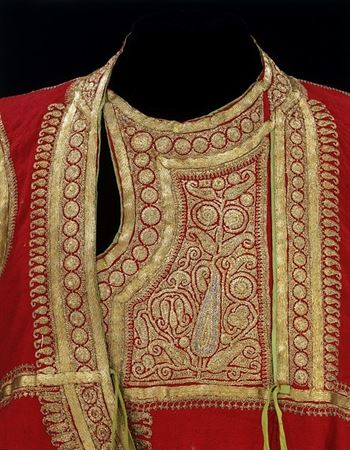The word angarkha is supposed to be taken from the Sanskrit Angrakshak which means to protect the limbs.
It is long Indian robe with an asymmetrical opening in the chest area reaching down to the knees, which was very popular in N.India in the 19th century and is also worn with slight variations by men in western India .
The different types of angarakhas are frock style, waist-length kamari angarakha and the long angarakha which reaches below the knees. Matrerials used would depend on weather and occasion: muslin with chikankaari for summers, brocade and velvet for festive occasions .
Perhaps the most famous weare of the angarkha was Nawab Wajid Ali Shah and this portrait of him with a bit of bare chest is one of his most famous pictures.
Unlike this portrait, men didn’t show bare chest and the flap covering the chest was tightly tied by flaps to both sides of the angarkha.
It typically has a front open with two flaps and one of the flaps (right) will have a covering for the chest attached to it which is then tied with strings to other side.
This is the frock styled angarkha which was made of very fine muslin and the cut can be seen in this book which is in the Metropolitan Museum site
In the angarkha given below you can see how it is tied and supposed to be worn.
A typical angarkha which I have seen people wear in my childhood, especially during Moharrum keeping in line with the standard set by MIr Anees the master of the craft of marsiya ( elegy writen on the Battle of Karbala). Marsiyakhwaans ( those who recited marsiyas would wear angarkha and do palli topi with chauda (wide rimmed) pyjama . I have seen my uncle Syed Tanvirul Hasan wear the angarkha while reciting marsiya and I have one of his cotton angarkhas as a memento.
Famous Dastangos Danish Hussain and MAhmood Farooqi have revived the lost art form of story telling or dastangoi.
They not only tell traditional tales but dress as the dastangos of the Mughal and later period in Delhi and Awadh used to : White muslin angarkha , chaudi mori ka pyjama ( wide pyjamas) and a do palli topi. Do palli topi is unique to the subcontinent.
This angarkha made of brocade was for festive occasions and worn in the non summer months. Summers it was always cotton/muslin in keeping with the weather.
An intricately embroidered angarkha for royalty now kept in a museum.
In West India the angarkhs was adapted to become an angarkhi just below the waist and worn with dhoti instead of pyjama
Of course nowadays angarkhas have been adapted for women and we rarely see men wearing it
To differentiate the photograph given below is of a sherwani which is a completely different cut and design

